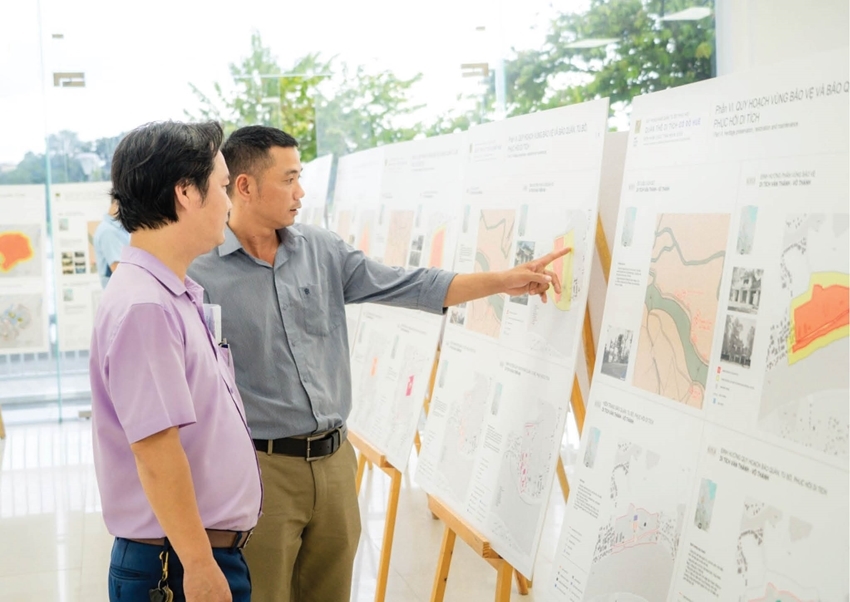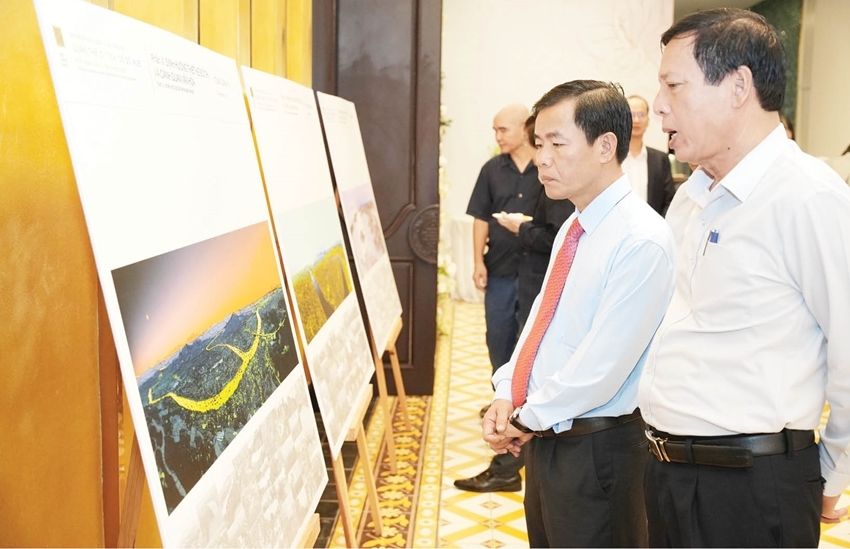 |
| Viewing the detailed planning of the Complex of Hue Monuments until 2030 at the exhibition |
Consecutive planning
Since the UNESCO recognition as a world cultural heritage, Vietnam's first tangible cultural heritage, the Complex of Hue Monuments has gone through two planning stages (the periods of 1996 – 2010, and 2010 - 2020).
Thanks to the attention of the Government, ministries, centrally governed agencies, as well as effective assistance of experts and the international community, the preservation of the Complex of Hue Monuments has been successfully implemented and achieved many proud results.
There have been hundreds of relics preserved, repaired, and restored, so far. Among these, there are many big works with typical historical and artistic values. Intangible cultural heritages have also been focused on preserving and promoting effectively. The face of Hue’s heritage has been constantly changing, gradually reviving to its historical appearance, and rising with increasingly intense vitality.
According to the Chairman of the Provincial People's Committee, Nguyen Van Phuong, ministries and centrally governed agencies have made the most favorable conditions for Thua Thien Hue to develop recently. At the same time, many specific mechanisms and policies are promulgated to establish an important legal basis for comprehensive strategies of preserving and promoting the values of both tangible and intangible heritages, environmental landscapes, and international exchange and cooperation expansion.
The Plan for preservation, repair, and restoration of the Complex of Hue Monuments until 2030, with a vision towards 2050 was approved by the Prime Minister on January 11, 2022, by Decision No. 42/QD-TTg. This serves as a basis for Thua Thien Hue province to proceed with the preparation and implementation of the project, as well as conducting an opinion poll. The Deputy Director of Hue Monument Conservation Center, Phan Van Tuan, said that this project is a larger scale continuation of the project No. 818 (in the period of 2010 - 2020) approved by the Prime Minister.
 |
| The Chairman of Provincial People’s Committee Nguyen Van Phuong (front row) at the exhibition |
Larger scope and scale
The scope of the planning includes the establishment and development of the historical ancient capital, landscapes, landmarks, locations, and natural boundaries closely related to the process of forming the Complex of Hue Monuments: Hue Citadel, Kim Long, Bao Vinh, Gia Hoi, Kim Phung Mount, Ngu Binh Mount, Due Mount, Vong Canh hill, Hen islet, Da Vien islet, Thuan An seaport, Tam Giang - Cau Hai lagoon, Huong River basin and tributaries within the administrative boundaries of Hue city, Huong Tra town, Huong Thuy town, Quang Dien district and Phu Vang district. The total area is about 134,000 hectares.
In particular, the scale of the planning will cover the World Cultural Heritage protection area and the Complex of Hue Monuments. These include the relics of Hue Citadel, Thien Mu Pagoda, the Temple of Literature and the Temple of The Military, the Colosseum, Nam Giao Altar, Hon Chen Temple, and the royal tombs of Duc Duc, Tu Duc, Dong Khanh, Thieu Tri, Khai Dinh, Minh Mang, Gia Long, and Hai Thanh town.
The conservation area of Huong River landscape is associated with the relics, and the spatial axes and lines of cultural landscapes and long-standing settlements associated with each relic. Areas for organizing activities to promote the values of relics connect the internal technical infrastructure with the related transportation systems and public infrastructure.
The Director of Hue Monument Conservation Center, Hoang Viet Trung, said that the planning objective is to fully recognize the value of the Complex of Hue Monuments, preserve the cultural heritage, natural landscape, and ecological environment of the Complex. This makes the Complex of Hue Monuments the nucleus and driving force in the implementation of the strategy to develop Thua Thien Hue into a city of heritage.
“The planning also helps to complete setting the boundaries and scope of zoning for relic protection, as well as proposing solutions to improve sustainable conservation capacity, adapt to climate change, and create a premise for effective economic development associated with heritage development. At the same time, it creates favorable conditions for people living in heritage areas to participate in preserving and promoting those values,” Mr. Trung said.
|
|
In the planning project, Thua Thien Hue will have become a city of Festivals, and a unique cultural, educational, tourism and medical center of Asia by 2050. The ancient capital of Hue with the Complex of Hue Monuments as the nucleus will have been built on historical traditions, the diversity of nature, culture, institutions, and human resources to become a global model of sustainable conservation of heritage that can grow with urban development by 2050.
|